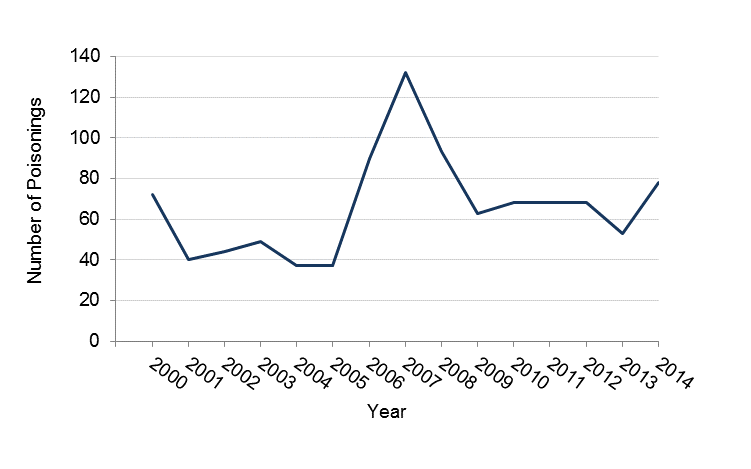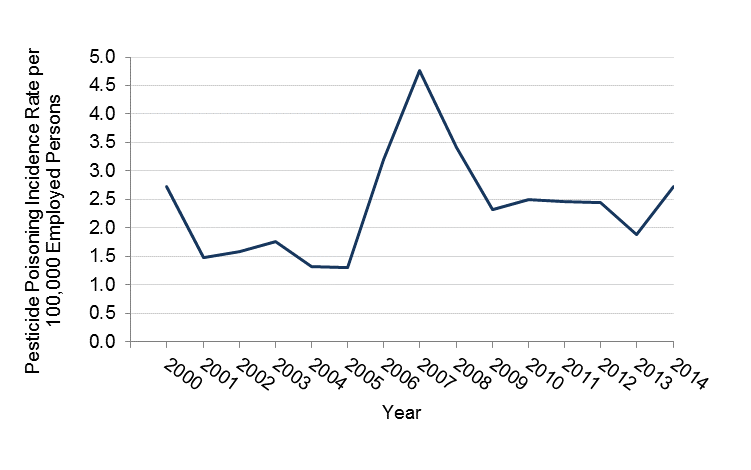Acute Work-Related Pesticide Associated Illness and Injury Reported to Poison Control Centers
When used appropriately, pesticides provide a variety of benefits to society: increasing crop production, preserving produce, and controlling insect and exotic species infestations. However, exposure to pesticides (insecticides, herbicides, and fungicides) may also confer a health risk to people. Consequently, they are heavily regulated to ensure proper usage and application. Even with heavy regulation, incidents of exposure through misuse or improper application still occur. Individuals who are mixing, applying, or working in areas that receive pesticide applications are at increased risk of exposure.
This indicator identifies the number and rate of acute work-related poisonings that occur each year due to pesticide exposure based on data from the Minnesota Poison Control Center. This indicator only includes cases that (1) have been recognized as pesticide related, (2) resulted in a call to the Minnesota Poison Control Center to report the incident, and (3) are determined to be work-related. Because many cases of work-related pesticide poisonings may not be reported to the Minnesota Poison Control Center, there is a large undercount in the number of cases. However, this indicator does provide a measure of the magnitude of poisonings that occur each year.
Reported Work-Related Pesticide Poisoning Cases in Minnesota, 2000-2014
| Year | Number | Rate per 100,000 Employed Persons Age 16 or Older |
| 2000 | 72 | 2.7 |
| 2001 | 40 | 1.5 |
| 2002 | 44 | 1.6 |
| 2003 | 49 | 1.8 |
| 2004 | 37 | 1.3 |
| 2005 | 37 | 1.3 |
| 2006 | 90 | 3.2 |
| 2007 | 132 | 4.8 |
| 2008 | 93 | 3.4 |
| 2009 | 63 | 2.3 |
| 2010 | 68 | 2.5 |
| 2011 | 68 | 2.5 |
| 2012 | 68 | 2.5 |
| 2013 | 53 | 1.9 |
| 2014 | 78 | 2.7 |
This table shows the number of pesticide poisoning cases reported to the Minnesota Poison Control Center to be work-related during 2000 – 2014. The rate per 100,000 employed persons greater than 16 years of age is also included on the table.
A change in the definition of an occupational pesticide poisoning case between 2005 and 2006 requires that one use caution when comparing years prior to 2005 to the time span including 2006 to the present.
The National Institute for Occupational Safety and Health(NIOSH) has developed the Sentinel Event Notification System for Occupational Risk (SENSOR)-Pesticides program in an attempt to build capacity for tracking pesticide related illness and injury. Eleven states participate in the SENSOR-Pesticides program. Five are funded by NIOSH (California, Michigan, Iowa, New York, and Washington) and six are unfunded or receive EPA funds (Florida, Louisiana, New Mexico, North Carolina, Oregon, and Texas) to conduct surveillance for occupationally-related pesticide illnesses and injuries. The cases collected by these states are then reported back to NIOSH in an attempt to describe what might be occurring at the national level in regards to work-related pesticide illness and injury. The Environmental Protection Agency (EPA), a partner with NIOSH in the provision of funds to several states that conduct SENSOR activities, estimates that between 10,000 and 20,000 pesticide poisonings occur each year in the approximately 2 million U.S. agricultural workers (http://www.cdc.gov/niosh/topics/pesticides/). A map showing the incidence rate of acute work-related pesticide poisonings for each state from 2000-2013 is available at the NIOSH SENSOR-Pesticides Program web site.
Acute Occupational Pesticide-Related Illness Cases (11 SENSOR states)*
| Year | Number | Participating States |
| 2000 | 617 | 8 |
| 2001 | 553 | 9 |
| 2002 | 597 | 8 |
| 2003 | 610 | 9 |
| 2004 | 571 | 8 |
| 2005 | 651 | 9 |
| 2006 | 761 | 10 |
| 2007 | 974 | 10 |
| 2008 | 912 | 11 |
| 2009 | 677 | 10 |
| 2010 | 750 | 10 |
| 2011 | 853 | 11 |
| 2000 - 2011 | 8,526 | -- |
Number of Work-Related Pesticide Poisonings Reported in Minnesota, 2000-2014

Rate of Work-Related Pesticide Poisonings Reported in Minnesota, 2000-2014

A trend analysis of the number of work-related pesticide poisoning cases from 2000 to 2014 did not find any statistically significant increase or decrease in the number of cases from year to year. Continued surveillance will be necessary to evaluate the effectiveness of educational and regulatory practices in reducing future pesticide poisonings.